
|
Olympus E-M1 in Infrared |

|
My other articles related to the |
|
This is just a quick note about how responsive the E-M1 is to infrared. I realize that December is not the best time to check that (not at our latitudes, that is), because there is no green foliage giving the pleasant bright-green effect, but we can't change that, and as soon as in March I hope to post some new samples, showing that (or I may have to go somewhere warmer, somebody's got to do it).
Before proceeding, you may want to check my general introduction to infrared photography with digital cameras (which I've been maintaining and updating since 2000!).
| This is a straight shot of the scene used for my first sample. There were still some autumn leaves still left on the trees, therefore I was expecting some Woods effect. The same scene shot through a Hoya R72 IR filter is shown below left; after desaturation and tonality adjustment — below right. SXGA-sized images can be viewed by clicking on the ones shown.
| 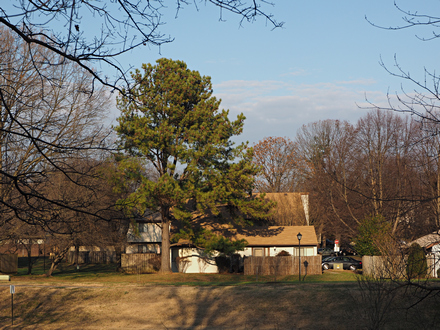
EM-1, 12-50 mm MZD at 40 mm,
|
| 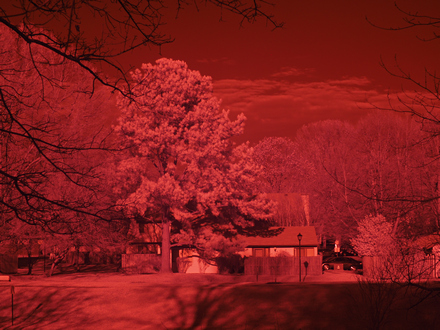
Same as above, but with Hoya R72 filter:
| 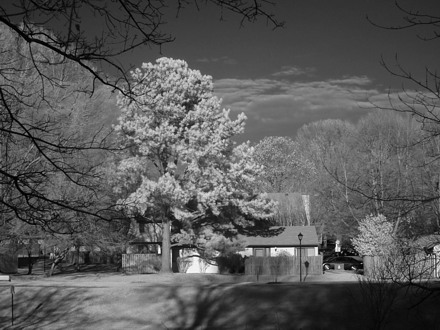
Image at left after desaturation and re-equalization | |||
|
Forget about getting greens bright; not this time. What counts now is that, in spite of the anti-IR filter in front of the sensor, the camera still has some IR sensitivity left, if barely usable by daylight.
The exposure factor is, on average, close to 1000× which is 10 EV; comparing visible-light and IR frames from a number of scenes I was getting that consistently between 9.7 and 10.3 EV. This is the same sensitivity as that for the E-510, about 1 EV better than for the E-30 and E-620.
| 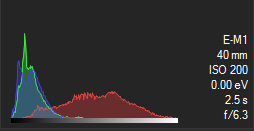
You can use the auto-exposure in the E-M1 without adding a compensation, although -0.3 or -0.7 EV may be a bit better, preventing the red channel from overloading. The autofocus is barely working at these light levels, and while it was used in this sample, in some others I resorted to manual focusing.
| | |
|
Thus, things are as expected for a CMOS sensor: while there is some IR sensitivity in the E-M1, it is barely enough for shooting static objects in bright sunlight.
What helps a bit is the very efficient image stabilization system in this camera. A few days later (after a rogue snowfall) I shot a few more pictures in infrared. This time I did not use a tripod, therefore I've set the gain to ISO 6400; I also closed down the 12-40 mm lens to F/8 and used manual focusing.
|
| 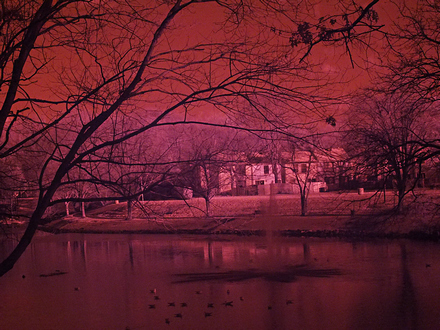
E-M1 with 12-40 mm F/2.8 ZD at 40 mm, Hoya R72 filter
| 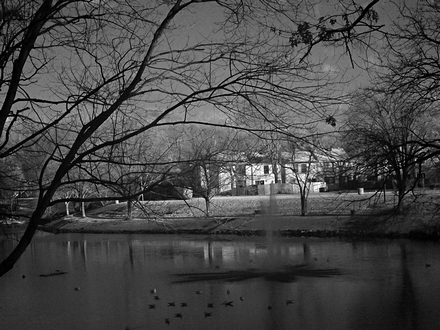
Image at left after desaturation and re-equalization
| The good news is that at this focal length (40 mm) and with the IS active, the E-M1 is quite handholdable at exposures of 1/2 s or so; not a single frame out of six I've shot was made unusable by the blur, if just two were really OK. (In the original posting I was too forgiving; re-inspecting the images shows two frames really good, and four where the camera shake effect, while visible, is not obvious.) These almost-handholdable speeds were also made possible by setting the ISO to 6400, which is perfectly fine for this application. The Olympus SLRs I've used in IR before were very noisy at high ISOs in IR; while some people may like this effect, some may not. For the IR grain effect on the E-M1 I will have to resort to ISO 25600. What remains now is to wait for the spring foliage. Converting your OM-D camera to IR OM-D (or, in general, μFT) cameras are perfect candidates for IR conversion. Not being SLRs, they get all information they need from the image sensor (not separate AF and AE other sensors which do not know anything about conversion). Therefore replacing the anti-aliasing (anti-dust, anti-IR combined) filter with some R72 glass would not only increase the camera's IR sensitivity by three orders of magnitude, but it should also retain all autoexposure and autofocus functionality. While I am unwilling to submit my E-M5 to this surgery (it is serving as a back-up body), I'm sort-of considering getting a second-hand μFT compact to give it a try. | ||||

|
My other articles related to the |
| This page is not sponsored or endorsed by Olympus (or anyone else) and presents solely the views of the author. |
| Home: wrotniak.net | Search this site | Change font size |
| Posted 2013/12/14; last updated 2013/12/15 | Copyright © 2013 by J. Andrzej Wrotniak |